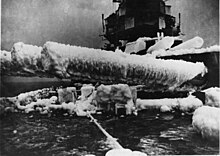Convoy JW 51B
| date | December 30, 1942 to January 3, 1943 |
|---|---|
| place | Barents Sea |
| output | Allied success |
| Parties to the conflict | |
|---|---|
| Commander | |
|
Combat group: Submarines: |
Convoy:
Close security: Force R: Remote backup: |
| Troop strength | |
|
Combat group:
Submarines:
Air fleet 5 |
Close security:
Force R:
Remote backup:
|
| losses | |
|
1 destroyer |
1 destroyer |
JW 51B was the name of an allied northern sea convoy that set out at the end of December 1942 to transport supplies for the Red Army from Great Britain to Murmansk through the northern sea . The convoy was attacked by a combat group of the Kriegsmarine , whose subsequent battle with the escort's security ships became known as the Battle of the Barents Sea .
Positioning, discovery
Unlike the previous convoys with the identification "PQ" that had left Iceland , those with the "JW" identification ran out of Loch Ewe in Scotland . The new route brought them closer to the bases of German armed forces - but the northern route taken by the PQ convoys was impassable because of the pack ice border, which shifted south in winter.
The ships of JW 51B gathered in Loch Ewe and left on December 22, 1942 with destination Murmansk . It comprised 15 merchant ships, nine under the US, five under the British and one under the Panamanian flag, led by Commodore Captain RA Melhuish of the Royal Indian Navy on the freighter Empire Archer .
The protection of the freighters was ensured by the escort under Captain Robert Sherbrooke , who was under the command of six destroyers , two corvettes , a mine sweeper and two armed trawlers .
"Force R" under Rear Admiral Robert Burnett with the cruisers Sheffield , Jamaica and two destroyers was intended as security against possible surface attacks for the second part of the convoy route and was supposed to meet the association on December 29, coming from Murmansk.
The remote security was incumbent until the handover to "Force R" on December 29, an association of the Home Fleet under Admiral John Tovey with the battleship Anson , the heavy cruiser Cumberland and five destroyers.
Discovery and approach
The formation of the convoy was reported early by German agents, the convoy itself was discovered by a reconnaissance aircraft on December 24th and, despite bad weather, shadowed by other aircraft on the 27th and 28th, which sent the composition and security to their command posts. The destroyer Oribi from the security group had already lost the escort at the height of Bear Island in a storm, so that at that time he was no longer available to protect the merchant ships. A cargo ship, Dover Hill , sailing under the British flag , had to turn back due to engine failure.
On the 29th, the German submarine U 354 came within sight of the escort and radioed the position of the battle group with the heavy cruiser Admiral Hipper and the armored ship Lützow before it was pushed away by the escort.
Battle and rescue of the convoy
Battle of the Barents Sea
On December 31, at 8:30 a.m., the sailors discovered the indistinct shadows of destroyers in the fog in the lookout of the destroyer Obdurate and the corvette Hyderabad . They initially thought they were Soviet ships. To resolve the unclear situation, Captain Sherbrooke dispatched the Obdurate to identify the ships. The unknown units were the German destroyers Friedrich Eckholt , Z 29 and Richard Beitzen , who opened fire on the obdurate at 9:30 a.m.
The German task force had previously split. While the group around the cruiser Admiral Hipper drew and distracted the escort security in poor visibility conditions, the group around the armored ship Lützow tried to track down the fleeing convoy with the merchant ships in order to sink its ships. However, this project failed because the merchant ships were not attacked between banks of fog and snowstorms in the twilight of the arctic winter.
Instead, the German ships got entangled in a sea battle with the escort and the light cruisers of the "Force R" that had rushed up before they finally gave up the attack. Two escort ships, the destroyer Achates and the minesweeper Bramble , had been sunk.
Arrival of the convoy
JW 51B reached Kola Bay on January 3, 1943 without further losses . The 14 remaining merchant ships delivered:
- 2,046 vehicles
- 202 tanks
- 87 fighters
- 33 bombers
- 11,500 tons of fuel
- 12,650 tons of aviation fuel
- 54,321 tons of other freight
literature
- Richard Woodman: Arctic Convoys 1941-1945. Pen & Sword Books, 2007, ISBN 978-1844156115 .
- Georges Blond: Course Murmansk - The Fateful Voyages of the Allied Arctic Ocean Convoys. Stalling Verlag, Oldenburg 1957; Original title: Convois Vers l´URSS. Librairie Arthème Fayard, 1950.
- Stephen Wentworth Roskill: Royal Navy. Stalling Verlag, Oldenburg 1961; Original title: White Ensign. USA 1960.
Web links
- Richard Hawes and Richard Kenney: Order of Battle. The Battle of the Barents Sea. The Attack on Convoy JW 51B, December 31, 1942. on navweaps.com
- SA Kerslake: Chapter Seven - CONVOY JW51B. on naval-history.net
